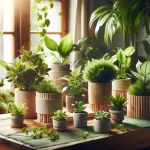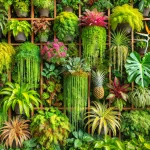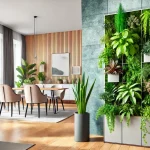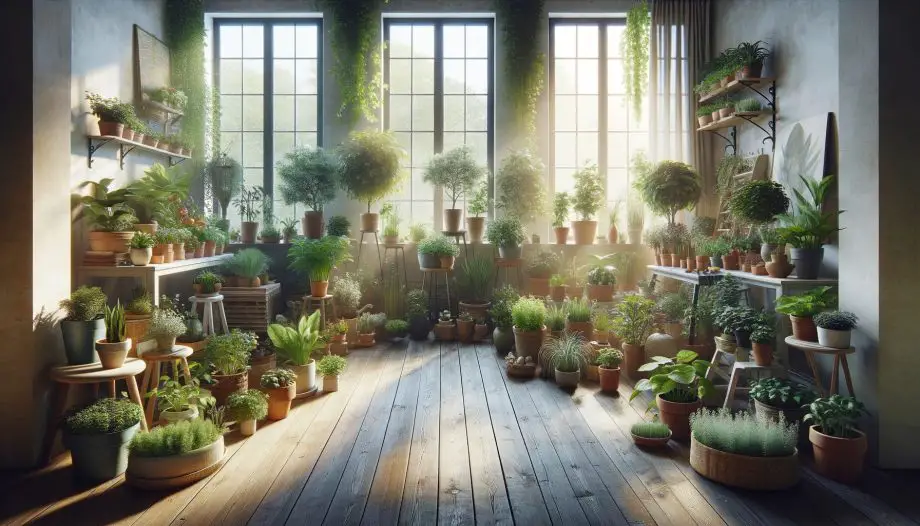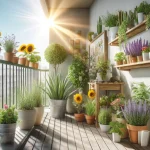This post may contain affiliate links. If you buy something from one of our links we may earn a commission. Thanks
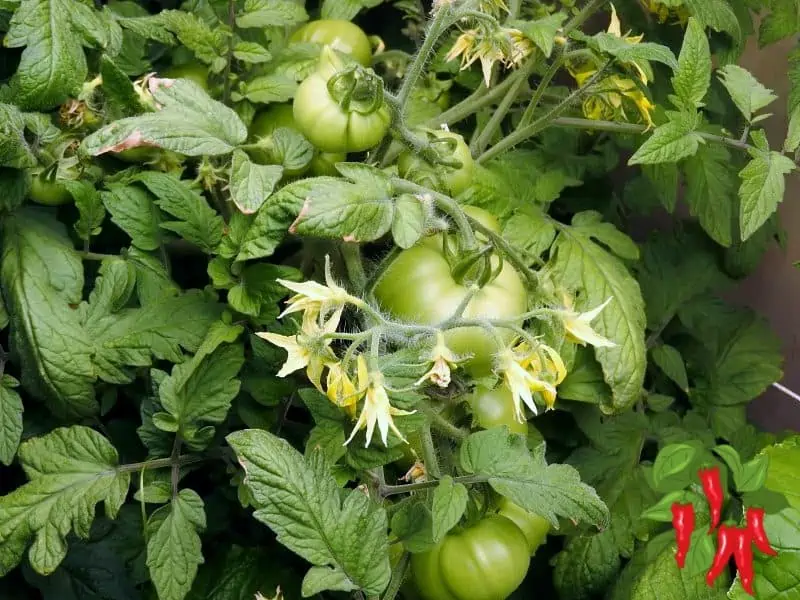
Howdy, everyone! Are you living in an apartment without a balcony and thinking, “Well, there goes my gardening dream”?
Hold your horses because I’ve got some green-thumb magic up my sleeve! In this guide, we’re diving into the world of indoor gardening, showing you that lack of outdoor space is no barrier to growing your own lush oasis.
I live in an apartment without a balcony and although a balcony would be nice it has not stopped me from gardening and growing a diverse amount of vegetables and house plants.
It shouldn’t stop you either so in this blog post I spill the beans on gardening in an apartment without a balcony.
From vertical gardens to windowsill wonders and microgreens, we’ve got tips and tricks to turn your apartment into a plant paradise.
So, let’s roll up our sleeves, get our hands a little dirty, and discover how to bring the joy of gardening into your cozy indoor space.
Ready to get started? Keep it green, and let’s dig in!
Gardening in an Apartment Without a Balcony Key Takeaways:
- Gardening in an apartment without a balcony is entirely possible.
- Use vertical space, windowsills, and hanging planters for herbs, succulents, and more.
- Optimize light with LED grow lights and choose plants that thrive indoors, like pothos or spider plants, to create a vibrant, green indoor oasis.
Introduction: Gardening in an Apartment Without a Balcony
Welcome to the ultimate guide for gardening in an apartment without a balcony!
Whether you’re a seasoned gardener or just starting out, this guide is packed with tips, tricks, and inspiration to help you create a thriving indoor garden in any space.
From selecting the right plants to maximizing natural light, we’ll cover everything you need to know to bring a touch of greenery into your home.
So, let’s get started and transform your apartment into a lush, green sanctuary!
The Joys of Indoor Gardening:
- Picture this: a little green oasis right in the heart of your apartment. Indoor gardening is not just about adding a splash of color; it’s about creating a space that brings you joy and serenity.
- Imagine sipping your morning coffee surrounded by lush leaves and blooming flowers, or cooking with fresh herbs plucked straight from your windowsill. It’s a small way to connect with nature, improve air quality, and even boost your mood!
No Balcony? No Problem!:
- So, you’re thinking, “But wait, I don’t have a balcony!” Well, my friend, that’s the beauty of indoor gardening. You don’t need a balcony or a sprawling outdoor space to grow your green thumb.
- With a bit of creativity and the right tips (which I’m about to share), you can transform any corner of your apartment into a thriving garden. So, let’s leave those balcony blues behind and embark on this indoor gardening adventure together!
Key Apartment Garden Takeaways:
- Gardening in a small apartment is feasible and rewarding.
- Utilizing vertical space, windowsills, and innovative solutions like hanging planters.
- Selecting the right plants and optimizing light for a thriving indoor oasis.
- Apartment gardening has many benefits, including improving air quality, reducing stress, and saving money.
- When gardening in an apartment without a balcony, consider growing herbs, succulents, microgreens, or air plants and investing in self-watering planters.
Embracing Vertical Gardening
When floor space is scarce, it’s time to think up, not out! Vertical gardening is a game-changer for apartment dwellers, turning blank walls into lush living art.
In this section, we’ll explore the ins and outs of vertical gardening, from the benefits of going vertical to creative ideas like wall-mounted planters, shelves, and hanging baskets. Get ready to see your walls in a whole new light!
- Why Go Vertical?
- Space Savers: Vertical gardening is a genius way to make the most of limited square footage. By growing upwards, you can add greenery without sacrificing precious floor space.
- Aesthetic Appeal: Transform bare walls into stunning living walls. Vertical gardens add texture, color, and life to any room, creating a focal point that’s sure to impress.
- Accessibility: With plants at eye level, watering, pruning, and harvesting become a breeze. No more bending or crouching to tend to your green friends!
- Vertical Gardening Ideas:
- Wall-Mounted Planters: Perfect for herbs, succulents, or small flowers, these planters bring a modern touch to your indoor garden.
- Shelves: Staggered shelves can house a variety of plants, offering flexibility and allowing you to create a personalized plant display.
- Hanging Baskets: Ideal for trailing plants, hanging baskets add a touch of whimsy and free up floor and wall space for other decor.
With these tips and ideas, you’re well on your way to creating a vertical garden that’s both beautiful and functional.
So, let’s climb to new heights and turn those walls into green masterpieces!
What’s So Great About Apartment Gardening?
Hey there, my fellow apartment dwellers! Let’s talk about the perks of apartment gardening.
It’s not just about adding a splash of green to your space; it’s about reaping some awesome benefits for both your well-being and your wallet. Here’s the scoop:
- Breathe Easy with Better Air Quality: Our leafy friends are like natural air purifiers. They gobble up carbon dioxide and pump out fresh oxygen, making our indoor air cleaner and fresher. They even tackle some of those pesky indoor pollutants like benzene and formaldehyde. Plus, they add a bit of humidity to the air, which is a nice bonus for keeping our respiratory systems happy.
- Chill Out with Less Stress: There’s something about caring for plants that just chills us out. It’s like a little nature escape right in our living rooms. Watering, pruning, and watching our plants grow can be a super relaxing break from the fast-paced city life. It’s a bit of green therapy that can soothe our minds and boost our moods.
- Save Some Green with Homegrown Veggies: Who knew gardening could be a money-saver? Growing your own veggies and herbs means fewer trips to the grocery store and more cash in your pocket. Plus, there’s something extra tasty about eating food you’ve grown yourself. It’s a win-win for your taste buds and your budget.
So, there you have it! Apartment gardening is not just about making your space look pretty (though that’s a nice perk).
It’s about cleaner air, less stress, and saving some money. Now, who’s ready to get their hands a little dirty and turn their apartment into a green oasis?
Windowsill Wonders: Making the Most of Your Sunny Spots
Hey there, green thumbs! Don’t overlook the goldmine that is your windowsill when it comes to apartment gardening.
These sunny spots are perfect for hosting an array of potted plants and herbs, giving them the light they need to thrive and adding a pop of green to your space.
- Sunlight Central: Placing your plants on the windowsill ensures they get plenty of natural light, which is key for photosynthesis and overall plant health. It’s like giving your green buddies front-row seats to the best show in town—the sunshine!
- Fresh Vibes & Flavors: Not only do windowsill gardens brighten up your living area, but they also provide you with fresh herbs and greens right at your fingertips. Imagine snipping some basil or mint straight from your windowsill for your next culinary creation!
- Space-Savvy Gardening: For those of us without the luxury of outdoor space, windowsills offer a clever way to bring a bit of nature indoors. You can grow a surprising variety of plants in this compact area, from succulents to small vegetables.
- Cozying Up on the Windowsill:
- Picking Your Plant Pals: Stick to the small and mighty, like herbs (think basil or chives) or cute succulents. They’re just the right size for your windowsill hangout.
- Pot Picks: Go for pots that have good drainage and fit snugly on your sill. No dangling over the edge, please!
- Let There Be Light:
- Share the Sunshine: Give each of your green buddies a turn to bask in the sun by rotating them regularly. It’s only fair!
- Light It Up: Not enough sunbeams coming through? A grow light can be a game-changer to keep your plants perky.
- Steer Clear of the Crowd:
- Room to Breathe: Space out your plants to keep the air flowing and prevent any leafy traffic jams.
- Trim Time: Keep things tidy by snipping off any wild growth. It’ll help your plants stay bushy and happy.
And there you have it! With these tips, your windowsill is well on its way to becoming a green haven.
So, grab your pots, pick your plants, and let’s get growing!
Choosing the Right Plants
Alright, green thumbs, let’s talk about picking the perfect plant pals for your indoor jungle.
Not all plants are cut out for the cozy life inside, so we’ve got to choose wisely. Here’s the scoop on selecting some low-maintenance, indoor-loving greenery:
- Plant Picks for Easy Living:
- Pothos: This trailing beauty is a real go-getter, thriving even in low-light spots. Plus, it’s a champ at purifying the air!
- Spider Plants: These funky, spiky pals are super forgiving and great for newbies. They also produce cute little plantlets you can share with friends.
- Succulents: If you’re a bit forgetful with watering, these are your best buds. They’re all about that low-water, high-sunlight life.
- Vegetables: Look for varieties labeled bush or compact.
- What to Think About When Choosing Plants:
- Light It Up: Match your plant’s light needs with what you’ve got. Some love a sunbath, while others are cool with a shady spot.
- Growth Spurts: Consider how big your plant will get. You don’t want a jungle giant taking over your space!
- Care and Feeding: Go for plants that fit your lifestyle. If you’re a low-maintenance plant parent, stick to easy-care varieties.
With these tips, you’ll be on your way to creating an indoor oasis with the perfect plant buddies that are just right for you and your space. Happy plant hunting!
Lighting Up Your Indoor Garden
Let’s shed some light on a super important topic: keeping your indoor garden bright and happy. Proper lighting is like the secret sauce for plant growth, so let’s dive into how to get it just right:
Why Light Matters:
-
- Sunshine in a Bottle: Plants are like mini solar panels, soaking up light to power their growth. Without enough light, they might get leggy, lose their vibrant colors, or even throw in the towel.
- Finding the Sweet Spot: Each plant has its own lighting preferences. Some love basking in the sun, while others prefer a more low-key vibe in indirect light.
Bright Ideas for Indoor Light:
-
- Natural Light: If you’ve got sunny windows, use ’em! South-facing windows are the MVPs for most plants, but east or west-facing ones can be great for those that prefer a little less intensity.
- LED Grow Lights: No sunny windows? No worries! LED grow lights are like a mini sun for your plants. They’re energy-efficient and can provide the full spectrum of light your green buddies need.
With these tips, you’ll be able to keep your indoor garden glowing and growing strong. So, let there be light, and watch your plant babies thrive!
Innovative Planters and Containers
It’s time to talk about the homes for your leafy friends – planters and containers!
With so many cool options out there, you can really get creative and find the perfect fit for each plant. Let’s dive into some of the nifty choices:
Types of Planters:
-
- Self-Watering Systems: If you’re a busy bee or a bit forgetful with watering, these are a game-changer. They have a reservoir that keeps the soil moist, so your plants stay hydrated without constant attention.
- Hanging Planters: Perfect for small spaces or adding some vertical flair, hanging planters let your plants dangle and dance in the air. Great for trailing plants like ivy or string of pearls!
- Recycled Containers: Get creative and eco-friendly by using old jars, cans, or even teapots as planters. Just make sure to add drainage holes to keep your plants happy.
- Maximizing Your Vertical Space: Hey there, space-savvy gardeners! If you’re working with limited floor space, it’s time to think vertically.
- Vertical Gardening Solutions: Trellises or hanging baskets can be a game-changer, especially for climbers like peas and beans.
-
- These nifty tools let your plants reach for the sky, freeing up precious floor space while adding a beautiful green touch to your home.
- So, why not let your plants climb their way to a gorgeous, space-efficient garden?
Choosing the Right Container:
-
- Size Matters: Make sure the container is the right size for your plant. It should have enough room for growth but not be so big that the soil stays wet for too long.
- Drainage is Key: Good drainage is a must to prevent waterlogged roots. Look for containers with holes in the bottom or get crafty and add your own.
- Material Magic: Different materials can affect how quickly the soil dries out. Terracotta is porous and great for plants that like drier soil, while plastic retains moisture better for thirstier plants.
With these tips, you can mix and match planters to suit your style and your plants’ needs. So, let’s get potting and give your green babies the stylish homes they deserve!
Take Advantage of Hanging Planters
Let’s jazz up that garden vibe with some hanging greenery! Imagine your place decked out with plants floating in the air, bringing that lush garden feel right into your living room without munching away at your precious floor space.
Hanging Planters: Your Green Magic Carpet
- Sky-High Greens: Hanging planters are like your greenery going vertical, turning any room into a scene straight out of a fairy tale. They’re a fantastic way to bring in more plants without cramming your floors or shelves.
- A Room with a View: Not just a space saver, hanging planters add a sprinkle of charm to any corner. They’re perfect for those viney plants that love to dangle and dance in the air, like ivy, pothos, or those spider plants that just can’t sit still.
- Flexibility is Key: The cool part? You can shuffle them around! Refresh your decor vibe or chase the sun by easily moving your planters to where they’ll thrive best.
- Care and Love: Just like any plant buddy, those in hanging planters need your love and attention. Keep them quenched and well-drained, and they’ll be the gift that keeps on giving.
- Matchy-Matchy: When picking out your planters, think about how they’ll gel with your place. You want them to be a snug fit for your plants but also to look like they were meant to be there, enhancing your home’s aesthetic.
Incorporating hanging planters is more than just a gardening trick; it’s about crafting that green sanctuary you’ve been dreaming about, one that breathes life into your space and keeps it feeling fresh. So why not give it a whirl?
How to Create a Garden in Your Apartment (No Balcony? No Problem!)
Hey there, fellow plant enthusiasts! Dreaming of a garden but lacking a balcony? With a dash of creativity and some clever solutions, you can transform your apartment into a lush indoor oasis.
Let’s explore how you can bring a garden into your home, no matter the size:
Reach for the Sky: Utilize Vertical Space
-
- Think Up, Not Out: Vertical gardening is a game-changer in small spaces. Use wall-mounted planters, hanging baskets, or even a DIY trellis to take your plants to new heights.
- Shelf It: Multiple shelving units can turn an empty wall into a vibrant garden display, offering a home for a variety of plants while keeping your living space open and airy.
Hanging Around: Use Hanging Planters

-
- Suspended Beauty: Hanging planters add a touch of whimsy and free up valuable floor space. They’re perfect for trailing plants like ivy or spider plants that can cascade down, creating a green waterfall effect.
- Flexible Decor: The beauty of hanging planters is their mobility. You can easily rearrange them to refresh your space or accommodate your plants’ growing needs.
Window Wonders: Make Use of Windowsills
-
- Sunlit Stage: Windowsills are prime real estate for plants that crave sunlight. Line them with potted herbs, succulents, or small flowering plants to create a vibrant display.
- Micro Gardens: Even in limited space, you can grow a mini herb garden or a selection of succulents on your windowsill, bringing fresh flavors and a touch of nature to your home.
Water Smart: Invest in Self-Watering Planters
-
- Stay Hydrated: Self-watering planters are a boon for busy plant parents. They ensure your plants get just the right amount of water, reducing the risk of over or under-watering.
- Low Maintenance: These planters are ideal for those new to gardening or with hectic schedules. They keep your plants happy and healthy with minimal effort on your part.
Creating a garden in an apartment without a balcony is not only possible but also incredibly rewarding.
It’s all about making smart use of your space and choosing the right plants and tools. So, roll up your sleeves, get creative, and bring a little green into your urban jungle!
Plant Care and Maintenance
Hey there, green thumbs! Keeping your indoor garden thriving is all about showing your plants some love and attention.
Let’s talk about the basics of plant care and how to keep those pesky problems at bay:
Keeping Your Plants Happy:
-
- Water Wisdom: Overwatering is a common oopsie, so make sure to check the soil moisture before giving your plants a drink. Stick your finger in the soil; if it’s dry a couple of inches down, it’s time to water.
- Pruning Pros: Snipping off dead or overgrown leaves not only keeps your plants looking sharp but also encourages new growth. It’s like a mini makeover for your plant!
- Feeding Frenzy: Plants need nutrients to grow strong, so give them a little boost with some fertilizer every now and then. Just follow the instructions on the package, and don’t overdo it – think of it as a light snack, not an all-you-can-eat buffet.
Troubleshooting Plant Problems:
-
- Pest Patrol: Keep an eye out for uninvited guests like aphids or spider mites. If you spot any, gently wipe them off with a damp cloth or use an insecticidal soap.
- Disease Defense: Yellowing leaves or spots might be a sign of trouble. Make sure your plants have good airflow and aren’t too crowded, and remove any affected parts to stop the spread.
- Nutrient Know-How: If your plants are looking a bit lackluster, they might be missing some key nutrients. Yellow leaves can indicate a nitrogen deficiency, while purple or red leaves might mean a lack of phosphorus.
By keeping these care tips in mind, you’ll be well on your way to nurturing a healthy, vibrant indoor garden. So, let’s roll up our sleeves and give our plant pals the TLC they deserve!
Coco Coir vs. Potting Soil: Why Coco is the Way to Go
Alright, plant enthusiasts, let’s talk about the battle of the growing mediums: coco coir vs. potting soil.
If you haven’t tried coco coir yet, you’re in for a treat. Here’s why this sustainable superstar is stealing the spotlight:
- Sustainability Superstar: Coco coir is made from the fibrous husks of coconuts, which means it’s a renewable resource. Unlike peat moss, which takes ages to regenerate, coco coir is a byproduct of the coconut industry, so it’s a more eco-friendly choice.
- Neutral pH Paradise: One of the coolest things about coco coir is its neutral pH level. This means it’s a great blank canvas for your plants, allowing you to control the pH balance more easily compared to potting soil, which can vary in acidity.
- Lightweight Champion: Coco coir is like the featherweight champion of growing mediums. It’s lighter than potting soil, making it a breeze to handle, especially if you’re moving pots around or gardening in a space with weight restrictions, like a balcony.
- Pot Size Reduction: Here’s a nifty perk – because coco coir has excellent water retention and aeration, you can actually get away with using smaller pots. You can reduce pot size by about a third, which is a space-saver and can also save you some cash on pots.
So, if you’re looking to make a switch from traditional potting soil, give coco coir a shot.
It’s a sustainable, pH-friendly, and lightweight option that might just be the perfect fit for your indoor garden. Happy planting!
Tackling the Challenges of Apartment Gardening
Hey, green thumbs! Apartment gardening is a fantastic way to bring some nature into your space, but it does come with its own set of challenges.
Let’s take a closer look at what you might face and how to overcome them:
-
Cozy Quarters: Limited Space Solutions
- Getting Creative with Containers: With limited floor space, it’s all about getting creative. Think vertical with wall-mounted planters, hanging baskets, or even a DIY trellis for climbing plants.
- Stack ‘Em Up: Stackable planters and tiered shelves are your best friends. They let you make the most of your vertical space and add a stylish touch to your indoor garden.

-
Let There Be Light: Overcoming Limited Sunlight
- Finding the Right Spot: Natural sunlight can be scarce in apartments, so position your plants near windows that get the most light. South-facing windows are usually a safe bet.
- Artificial Sun: When natural light isn’t enough, LED grow lights come to the rescue. They’re energy-efficient and can provide the full spectrum of light your plants crave.

By tackling these challenges head-on, you can create a thriving indoor garden that brings a touch of greenery to your urban oasis. So, let’s roll up our sleeves and get growing!
Growing Veggies in Your Apartment: Your Urban Garden Awaits
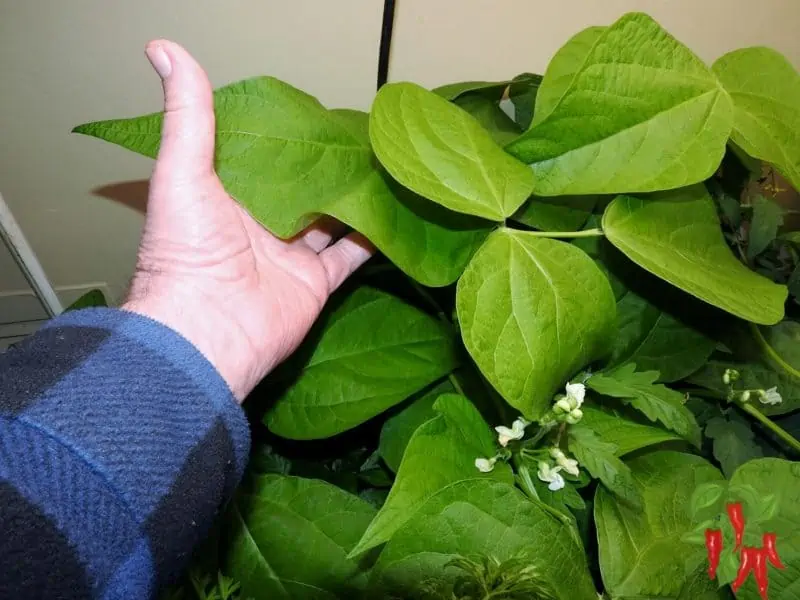
Ever fancied plucking fresh veggies straight from your apartment? Well, you’re in luck! Growing veggies in an apartment isn’t just doable; it’s downright delightful.
No need for a backyard or balcony. You can savor the taste of homegrown goodness right where you are.
Ready to embark on your urban gardening adventure? Let’s dive in!
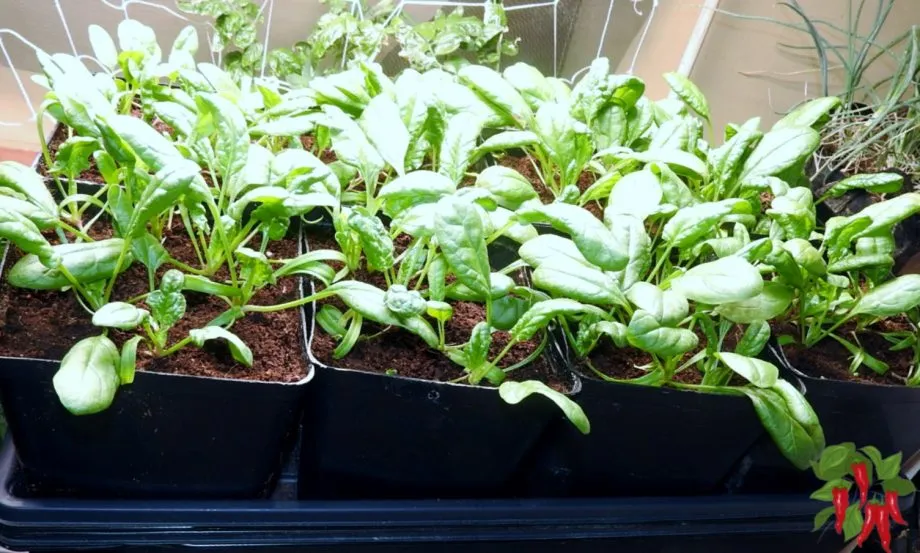
-
Picking the Perfect Veggies
- Choosing the Right Varieties: When it comes to apartment gardening, size matters. Go for veggies that play nice in cozy spaces and don’t need a sunbath all day long. Cherry tomatoes, radishes, lettuce, and baby carrots are your new best friends. They’re happy to chill in smaller pots and bask in the indoor glow.
- Soaking Up the Sun: Veggies love their sunshine, but not all need the same amount. Find a sunny spot near a south-facing window for those sun worshippers. If your place is more cave than a greenhouse, no worries! LED grow lights can step in to give your plants the light they need to thrive.
With these tips in your gardening toolkit, you’re all set to turn your apartment into a veggie haven.
So, let’s get growing and bring a burst of green into your urban jungle!
Light Requirements For Vegetables
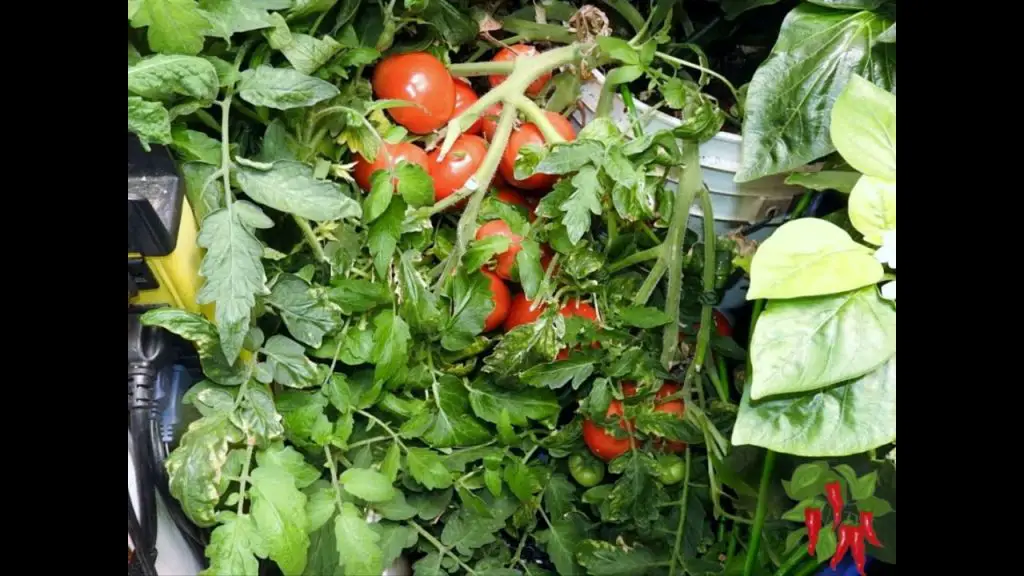
Here’s a table showing the light requirements for various vegetables:
| Vegetable | Light Requirements |
|---|---|
| Tomatoes | Full Sun (6-8 hours) |
| Peppers | Full Sun (6-8 hours) |
| Cucumbers | Full Sun (6-8 hours) |
| Beans | Full Sun (6-8 hours) |
| Peas | Full Sun (6-8 hours) |
| Lettuce | Partial Shade (3-4 hours) |
| Carrots | Full Sun (6-8 hours) |
| Onions | Full Sun (6-8 hours) |
| Radishes | Full Sun (6-8 hours) |
| Herbs | Partial Shade to Full Sun (4-6 hours) |
| Chard | Full Sun to Partial Shade (3-6 hours) |
| Kale | Full Sun (6-8 hours) |
| Arugula | Full Sun to Partial Shade (3-6 hours) |
| Mustard | Full Sun (6-8 hours) |
| Spinach | Partial Shade (3-4 hours) |
| Root Vegetables | Full Sun to Partial Shade (3-6 hours) |
This table will help you understand the amount of sunlight each vegetable requires for optimal growth.
Expanding Your Indoor Garden
Ready to take your indoor garden to the next level? As you get more comfortable with your green babies, it’s natural to want to branch out (pun intended) and add some new leafy friends to the mix.
Here are some tips for growing your indoor garden:
- Start Slow: Rome wasn’t built in a day, and neither is a lush indoor jungle. Add one or two new plants at a time, so you can get to know their needs without feeling overwhelmed. This way, you can ensure each plant gets the attention it deserves.
- Mix It Up: Variety is the spice of life, and it’s true for your indoor garden too! Try mixing different types of plants, like leafy greens, colorful flowers, or even some edible herbs. It’ll keep things interesting and add some visual appeal to your space.
- Get Creative with Placement: As your collection grows, think beyond the windowsill. Hanging planters, wall-mounted shelves, or even a plant stand can offer new homes for your expanding plant family. It’s like interior decorating, but with plants!
- Experiment with Propagation: Many plants, like pothos or spider plants, are super easy to propagate. Snip a piece, pop it in water, and watch it grow roots! It’s a fun and budget-friendly way to add more plants to your collection.
- Try New Techniques: Feeling adventurous? Why not dabble in hydroponics or try your hand at a DIY terrarium? Exploring different gardening techniques can keep things fresh and exciting.
Remember, expanding your indoor garden is a journey, not a race. Take your time, enjoy the process, and don’t be afraid to experiment. Happy gardening!
Mighty Microgreens: Small Space, Big Flavor
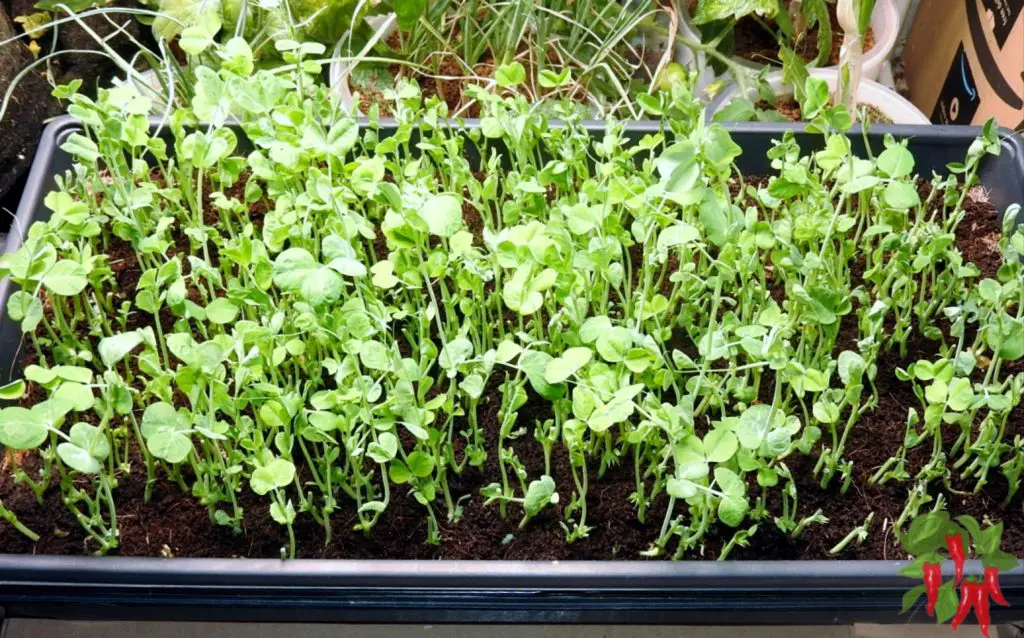 Let’s talk about microgreens, those tiny but mighty plants that are perfect for apartment dwellers like us.
Let’s talk about microgreens, those tiny but mighty plants that are perfect for apartment dwellers like us.
Microgreens are young vegetable greens, harvested just after the first leaves have developed.
They’re not only packed with flavor and nutrients but also super easy to grow, making them ideal for indoor gardening.
Plus, they’re fast-growing and take up very little space, so you can grow them right on your kitchen counter or windowsill.
Here are some easy tips to get you started:
- Choose Your Seeds: Start with seeds of your favorite greens, like radishes, arugula, kale, or basil. You can even find microgreen seed mixes for a variety of flavors.
- Get Your Tray Ready: Use a shallow tray or container with drainage holes. Fill it with a thin layer of seed-starting mix or potting soil, about an inch deep.
- Sow Your Seeds: Sprinkle the seeds evenly over the soil surface. You can sow them densely since they’ll be harvested young. Gently press them into the soil and mist with water.
- Cover and Wait: Place a clear plastic lid or plastic wrap over the tray to create a mini greenhouse effect. This helps keep the soil moist while the seeds germinate. Place the tray in a warm spot with indirect light.
- Let There Be Light: Once the seeds have sprouted, remove the cover and move the tray to a sunny windowsill or under grow lights. Keep the soil consistently moist with a spray bottle.
- Harvest Time: In just 1-2 weeks, your microgreens should be ready to harvest! Use a pair of scissors to snip them just above the soil line.
Growing microgreens is a fun and easy way to add fresh, homegrown greens to your meals.
Plus, it’s a great way to keep your green thumb active, even in a small space. So, give it a try and enjoy the fresh, vibrant flavors of your very own microgreens!
Another Square Foot Gardening Idea for Apartments
 Howdy, fellow plant enthusiasts! Who says you need a backyard or even a balcony to dive into gardening?
Howdy, fellow plant enthusiasts! Who says you need a backyard or even a balcony to dive into gardening?
Let me introduce you to the AeroGarden, a nifty little gadget that’s about to revolutionize the way you think about apartment gardening.
This compact, self-contained hydroponic system takes up less than a square foot of space, meaning you can set it up just about anywhere—on your kitchen counter, desk, or even a small shelf. So, no more excuses; it’s time to get growing!
- AeroGarden Magic: Discover the wonders of this space-saving hydroponic system that brings the joy of gardening right into your home.
- Set It and Forget It: Learn how the AeroGarden automates the growing process, making it a breeze for even the busiest city dwellers.
- Greens Galore: Explore the variety of plants you can grow in your AeroGarden, from herbs to leafy greens and even peppers and cherry tomatoes.
- Tips and Tricks: Get the inside scoop on how to maximize your AeroGarden’s potential and keep your indoor garden thriving.
With the AeroGarden, there’s no reason to miss out on the joys of gardening, no matter how small your living space might be.
Let’s embrace this modern gardening marvel and add a splash of green to our urban lives!
AeroGardens: The Future of Apartment Vegetable Gardening

Ready to revolutionize your apartment gardening game? Let me introduce you to the AeroGarden, the nifty gadget that’s changing the way we think about growing veggies indoors.
This bad boy is perfect for small spaces, offering a hassle-free way to cultivate fresh veggies right in the comfort of your home. Let’s dive into the world of AeroGardens!
-
Understanding AeroGardens
- What’s an AeroGarden, you ask? It’s a self-contained, hydroponic indoor garden system that takes care of most of the growing process for you, including lighting, watering, and nutrient delivery. It’s a dream come true for those of us living in apartments without traditional garden space.
- Benefits of Using an AeroGarden: These little wonders require no soil, which means less mess for you. Plus, their built-in LED lights provide all the sunlight your plants need to thrive. And did I mention they’re compact? You can easily fit one on your countertop or shelf.
-
Setting Up Your AeroGarden
- Choosing the Right Model: AeroGardens come in all shapes and sizes. Pick one that fits your space and the types of veggies you’re itching to grow.
- Initial Setup and Planting: It’s a breeze to get started. Just follow the instructions to assemble your AeroGarden, add water and nutrients, and pop in the seed pods. Most models even come with a starter kit of seeds.
-
Maintenance and Care
- Regular Monitoring: While the AeroGarden does a lot of the work for you, it’s still important to keep an eye on water levels and add nutrients as needed.
- Pruning and Harvesting: Give your plants a little trim now and then to encourage growth, and harvest your veggies when they’re ripe and ready.
-
Troubleshooting Common Issues
- Dealing with Pests and Diseases: Even in the controlled environment of an AeroGarden, you might encounter some pesky invaders. Keep a lookout and tackle any issues promptly with organic remedies.
- Managing Growth and Space: Some plants might get a bit too enthusiastic. Regular pruning will keep them in check and ensure they fit comfortably in your AeroGarden.
-
Enhancing Your AeroGarden Experience
- Experimenting with Different Vegetables: Don’t be afraid to mix things up! Try growing a variety of veggies to see what thrives best in your AeroGarden.
- Accessorizing Your AeroGarden: Want to expand your garden? Consider adding trellises for climbing plants or extra LED grow lights.
Final Thoughts
Using an AeroGarden for growing vegetables in an apartment is a smart, space-efficient way to indulge in gardening.
I own an AeroGarden Harvest and have been loving using it for the past 2 years.
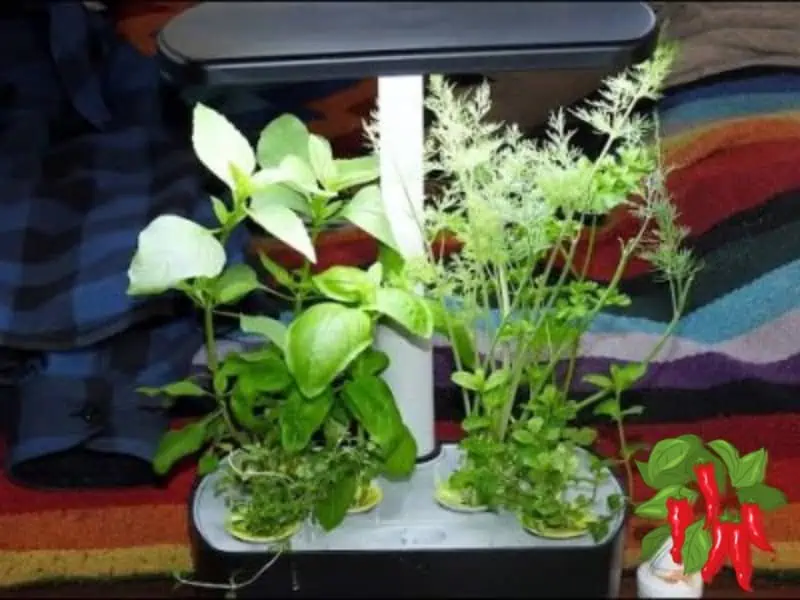
It’s perfect for beginners and experienced gardeners alike, offering a clean, automated, and rewarding gardening experience.
Using an AeroGarden for growing vegetables in an apartment is not just smart; it’s a space-efficient and enjoyable way to get into gardening.
So, why not give it a shot and enjoy the taste of fresh, home-grown vegetables all year round?
Exploring the Plant World in Your Apartment (No Balcony Required)
Hey there, green enthusiasts! Who says you need a balcony to unleash your inner gardener?
Your apartment can be a lush paradise with the right plants. Let’s dive into the world of indoor greenery that’s perfect for your cozy space:
- Herb Haven: Imagine having fresh herbs at your fingertips! Basil, mint, and cilantro can turn your apartment into a fragrant oasis. These little green buddies love the sun, so pop them on a windowsill or under a grow light for a daily dose of flavor and aroma. Just keep the soil moist (but not soggy) and snip away regularly to encourage bushy growth.
- Succulent Sanctuary: Succulents are the chill, low-maintenance pals of the plant world. They’re pros at storing water, so if you forget to water them now and then, they won’t hold a grudge. Echeveria ‘Lola’ and Haworthia ‘Zebra’ add a splash of texture and color to your space. Just give them a sunny spot and watch them thrive.
- Air Plant Adventures: Tillandsia, or air plants, are the cool kids on the block. No soil is needed—just plop them in a cute holder or terrarium, and you’ve got yourself a floating garden! Bright, indirect light and a weekly water bath are all they need to keep them happy and healthy.
Your apartment can be a vibrant, green haven with these plant pals. So, embrace the joy of indoor gardening and transform your space into a botanical wonderland!
Herb Haven:

Herb Haven: Imagine having fresh herbs at your fingertips! Basil, mint, and cilantro can turn your apartment into a fragrant oasis.
These little green buddies love the sun, so pop them on a windowsill or under a grow light for a daily dose of flavor and aroma.
Just keep the soil moist (but not soggy) and snip away regularly to encourage bushy growth.
-
- Culinary Delights: Fresh herbs like basil, mint, and cilantro are not only fragrant but also perfect for spicing up your dishes. Imagine whipping up a meal with herbs picked straight from your windowsill!
- Easy Care: These herbs thrive in sunny spots and don’t demand much. Keep the soil consistently moist, and they’ll reward you with endless flavor.
- Growth Tips: To ensure your herbs stay bushy and productive, make sure to use them regularly. This encourages new growth and keeps your plants happy.
Succulent Sanctuary:

- Succulents are the chill, low-maintenance pals of the plant world. They’re pros at storing water, so if you forget to water them now and then, they won’t hold a grudge. Echeveria ‘Lola’ and Haworthia ‘Zebra’ add a splash of texture and color to your space. Just give them a sunny spot and watch them thrive.
-
- Drought-Tolerant Dudes: Succulents are the laid-back friends in the plant world. They store water in their leaves, so they’re forgiving if you skip a watering or two.
- Stylish and Versatile: With their unique shapes and colors, succulents add a modern touch to any space. Pop them in geometric planters or create a mini succulent garden for a chic look.
- Design Tip: Group different succulents together for a visually appealing arrangement. Play with height, texture, and color to create a stunning display.
Air Plant Adventures:
-
- Tillandsia, or air plants, are the cool kids on the block. No soil is needed. Just plop them in a cute holder or terrarium, and you’ve got yourself a floating garden!
- Bright, indirect light and a weekly water bath are all they need to keep them happy and healthy.
- Soil-Free Living: Air plants, or Tillandsia, are the ultimate low-maintenance plants. They don’t need soil, so you can get creative with displays—hang them in glass orbs, mount them on driftwood, or tuck them into seashells.
- Carefree Care: These guys love bright, indirect light and a good soak in water once a week. Just make sure they dry out completely afterward to prevent rot.
- Display Ideas: Get creative with your air plants! Hang them from the ceiling in a macrame holder or create a living wall for a touch of greenery that doubles as art.
With these plant pals, you can transform your apartment into a green retreat. So, let’s get growing and bring a little bit of nature indoors!
Container Gardening for Apartment Dwellers
Hey, urban gardeners! Ready to dive into the world of container gardening? It’s the perfect solution for growing veggies in your apartment, no matter the size.
Let’s break down the basics to get your container garden flourishing:
Picking the Perfect Pots:
-
- Drainage is Key: Make sure your containers have holes at the bottom to prevent water from pooling and causing root rot.
- Size Matters: Think about the mature size of your plants. Some veggies need more elbow room to grow, so choose your pots accordingly.
Soil and Nutrition 101:
-
- Potting Soil Perfection: Grab some high-quality potting soil that’s designed for container gardening. It’s lighter and helps roots breathe and grow strong.
- Feed Your Plants: Mix in some organic fertilizer to give your plants the nutrients they need to thrive.
Water Wise Gardening:
-
- Stay Hydrated: Containers dry out quicker than garden beds, so regular watering is a must. But don’t go overboard—soggy soil is a no-no.
- Pest Patrol: Keep an eye out for uninvited guests like aphids or spider mites. A bit of neem oil or insecticidal soap can help keep them at bay.
Reaping the Rewards:
-
- Harvest Time: Pick your veggies when they’re ripe and ready. Regular harvesting can encourage your plants to produce even more goodies.
- Keep It Fresh: Succession planting keeps your garden in action. Once you’ve harvested one crop, plant another to keep the fresh veggies coming.
With these tips in your gardening toolkit, you’re all set to create a vibrant and productive container garden right in your apartment.
So, let’s get growing and enjoy the fresh, homegrown flavors all year round! Happy gardening!
FAQ Section: Navigating Apartment Gardening Without a Balcony
Welcome to our FAQ section, where we address common questions and concerns about apartment gardening without a balcony.
Whether you’re just starting out or looking to expand your indoor garden, we’ve got you covered with practical tips and solutions.
Q. Can I grow vegetables indoors if I don’t have a balcony?
A: Absolutely! You can grow a variety of vegetables indoors, such as lettuce, spinach, and tomatoes. Use pots or window boxes and place them in areas that receive sufficient sunlight.
Q. What are the best plants for indoor gardening in small spaces?
A: Herbs, succulents, and small flowering plants are ideal for small spaces. They require minimal space and can thrive on windowsills or in small containers. Popular choices include basil, chives, cilantro, dill, mint, oregano, parsley, and thyme.
Q. How can I ensure my indoor plants get enough light?
A: Utilize sunny windowsills and consider investing in grow lights, especially in areas with limited natural light. LED grow lights mimic the natural sunlight necessary for plant growth.
Q. What are some space-saving gardening techniques for apartments?
A: Vertical gardening and wall gardens are great space-saving techniques. You can also use hanging containers or try aquaponics, a soil-less gardening method.
Q. Is it expensive to start an indoor garden?
A: The cost varies, but it doesn’t have to be expensive. You can repurpose household items as plant containers and start with a few plants. Gradually expand your garden as your budget allows.
Q. Can I garden in an apartment without a balcony?
A. Yes, you can still garden in an apartment without a balcony. Various indoor gardening options can work in small spaces.
Q. What are some low-maintenance plants that can thrive in an apartment without a balcony?
A. Some low-maintenance plants that can thrive in an apartment without a balcony include pothos, spider plants, and peace lilies. These plants require minimal sunlight and can be grown in small containers.
Q. Do I need a lot of space to garden in my apartment without a balcony?
A. No, you do not need a lot of space to garden in your apartment without a balcony. Microgreens and AeroGardens work well for small space gardening.
You can use vertical gardening techniques, hanging plants, and small containers to maximize your space.
Hydroponic growing systems like AeroGardens are very compact and include lighting.
Q. How do I make sure my plants get enough sunlight in an apartment without a balcony?
A. You can place your plants near a window that receives ample sunlight, use artificial grow lights, or choose plants that thrive in low-light conditions.
Q. Can I grow vegetables and herbs in an apartment without a balcony?
A. Yes, you can grow vegetables and herbs in an apartment without a balcony. Some vegetables that can thrive indoors include cherry tomatoes, peppers, and herbs like basil and parsley.
Q. What are some creative ways to incorporate gardening in an apartment without a balcony?
A. You can use hanging planters, wall-mounted planters, and shelves to create a vertical garden. You can also use mason jars or recycled containers as planters. Another option is to join a community garden or utilize a shared outdoor space, if available.
Indoor gardening is a delightful and rewarding endeavor that brings the beauty of nature into your home. With these FAQs and tips, even the smallest apartment can become a lush, green space.
Conclusion: Growing Your Green Thumb in an Apartment
Well, folks, we’ve journeyed through the ins and outs of apartment gardening without a balcony, and I hope you’re feeling inspired and ready to roll up your sleeves.
Let’s take a moment to recap the key tips for indoor gardening success and encourage you to embrace this green adventure:
- Recap of Key Tips:
- Light It Right: Remember, light is life for your plants. Utilize sunny spots and supplement with grow lights if needed.
- Pick the Perfect Pots: Choose containers that suit your space and your plants’ needs. Don’t forget about drainage!
- Water Wisely: Avoid overwatering by checking the soil moisture and using well-draining potting mix.
- Feed Your Friends: Give your plants the nutrients they need to thrive with the right fertilizer.
- Keep It Clean: Prune dead leaves and keep your plants tidy to promote healthy growth.
- Embrace the Adventure:
- Start Small, Dream Big: Begin with a few plants and gradually expand your indoor garden as you gain confidence.
- Experiment and Learn: Don’t be afraid to try new plants and gardening techniques. Every plant tells a story, and every mistake is a lesson learned.
- Celebrate the Journey: Enjoy the process of nurturing your plants and watching them grow. There’s something magical about bringing a touch of nature into your home.
Apartment gardening is a wonderful way to connect with nature, add beauty to your living space, and even grow your own fresh herbs and veggies.
So, embrace the challenges, savor the rewards, and let your indoor garden flourish. Here’s to your green oasis in the city!
As we wrap up our exploration of growing vegetables in an apartment, it’s clear that limited space doesn’t have to limit your gardening dreams.
Read more: Indoor Apartment Gardening: 15 Point Comprehensive Guide
Resources: Indoor Gardening Tips
If you’re diving into the world of indoor gardening, these resources from educational institutions can provide valuable insights and guidance:
- University of Florida, IFAS Extension – Indoor Gardens: This resource offers tips on creating indoor gardens with compatible plants, considering factors like light, water, soil, and nutrients. It also discusses the importance of choosing the right plants for your indoor garden and provides advice on lighting and watering needs. Read more
- Utah State University Extension – Five Tips for Indoor Gardening: This article provides practical tips for successful indoor gardening, including choosing the right location, maintaining optimal temperature, selecting appropriate soil, managing pests and diseases, and picking suitable vegetables for indoor cultivation. Read more
- University of Georgia Extension – Growing Indoor Plants with Success: This comprehensive guide covers various aspects of indoor plant care, including soil selection, potting mixes, and growing mixes for different types of plants such as flowering houseplants, foliage plants, bromeliads, orchids, succulents, cacti, ferns, and African violets. It also provides tips on sterilizing soil and acclimatizing plants to indoor environments. Read more
These resources can help you create a thriving indoor garden, even without a balcony, by providing expert advice on plant selection, care, and maintenance.
Visit my Amazon Influencer Page for videos and gardening products Grow Your Own Garden














